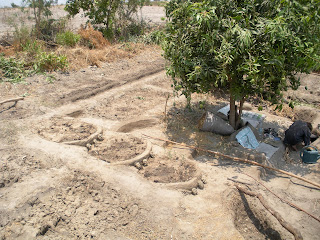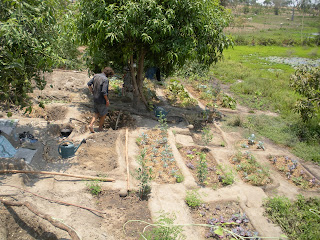Tabaski
Tabaski is the grandest of all Senegalese holidays. Generally every family slaughters a couple rams (or sheep if you can't get rams, or goats if you can't get sheep--the hierarchy is well-established). It's a mark of pride and status to be able to provide a ram for your family. Generally every man with a wife will provide one, but sometimes it falls on unmarried younger brothers and sons to scrape the money together for the animal. Since my host father and two brothers (all married) had the ram situation well under control I contributed a big sack of onions and another of potatoes. This combined with liberal use of the "no wife, no ram" excuse deflected most of those trying to convince me I should buy my own ram.
The routine for Tabaski in my village went something like this:
Slow morning around the home, eat breakfast, perhaps sweep the courtyard (I made a quick mission to my garden to plant some seeds and go for a run, this kind of behavior is discouraged since Tabaski is one of the few times people here DON'T go work)
Dress in your fancy new clothes bought especially for this day, and go to the big tree outside the village to pray (many women and some guys didn't go--I didn't go, nor did I dress in traditional Senegalese clothing. ***This subject merits further discussion--since I do so much to fit in with my community why don't I wear their clothes? The reason is that I really don't like wearing the traditional men's clothing. I was coerced into it during my time as a Trainee but now that it's up to me I want nothing to do with wearing what feels like an over-sized, starched, waxy, pillowcase. I admit the men look impressive and the women beautiful in their gorgeously patterned and personally tailored clothes, but I don't care to wear them myself. Since I have done so much to integrate here already (language, culture, work, relationships, etc) I feel I deserve some leeway to be an American and in doing so teach my community a bit about my own culture. My clothes are one of the few concessions I allow myself. I wore my best dress slacks and a nice button-up instead).
Come back and change into normal clothes, then slaughter the rams. Immediately afterwards they are all loaded onto a cart and pushed out to a nearby field to be skinned and butchered.
Deliver the meat to the women
Men = sit and talk for the next three days
Women = the same, except they have to get breakfast, lunch, and dinner prepared every day, so usually only dress up and socialize after dinner each night
I read a lot, visited a friend in another village, and spent plenty of time sitting and talking with family and friends around my hut
One of my cousins in his Tabaski splendor
Video of the Tabaski morning ram slaughter. *Disclaimer* Rated "R"-- bloodshed, animal cruelty
Slaughtering the rams in the morning of the first day
My brother Abib and me, hanging out in the evening on the second day of Tabaski
My mom, Aram, and some kids
My neighbors, dressed up for Tabaski
Troupe of girls in their Tabaski best
Coloring in my room
Baby rabbit. My two rabbits had five babies and they're growing up quick
Part of my awesome crew of kids showing off the shirts I brought them from the US. They are great, always hanging out with me, helping me with chores and projects, and explaining village stuff when I don't feel like talking to adults about it
Ramadan
I did not write this blog in chronological order, since Ramadan happened July 10th to August 8th and Tabaski was October 16th-18th.
Ramadan is one of the five pillars of Islam, when Muslims fast for 29-30 days during the 9th month of the Islamic lunar calendar. This fasting was not like anything I was used to in the States. Here we woke up at 4:30 am to eat breakfast before the sun rises, then no food or water until sunset at around 7:45 pm. At dusk we would "break fast" with some bread and tea, then eat "lunch" shortly after at around 8:30 pm, followed by very late "dinner" around 11 pm.
I decided from the beginning that I wanted to fast along with my family. I'm not Muslim but I am a part of the community and wanted to show respect and solidarity for their customs. I also wanted to see if I could handle the challenge. Since making the commitment to fast it was never exactly difficult to forgo food and water, i.e. I was never really tempted to cheat. But it was pretty miserable at times. The water. I was never hungry because thirst was so overwhelming. I worked in my garden in the mornings but after about 10 am I was done, and would just nap at the farm then wander home to sit on under the shade of my porch and read, write, draw, listen to music, or talk. People here would often go back out to work in the late afternoon, a truly impressive feat that I did not care to attempt.
Fasting for 30 days was a difficult but rewarding experience. I found myself reaching a peaceful state of focus when reading, writing, or drawing, as if the fasting left me physically drained but mentally sharp--unable to pursue more than one task at a time and often sluggish to switch tasks but when set and in-the-zone I was fully absorbed and all the more effective for the lack of distraction.
Fasting was also a tremendous source of respect and credibility--shared mutually. I got to see the sacrifice and tenacity of people here that fast for a month every year. They in turn where quite surprised that I--an American, non-Muslim, had never fasted before, etc--was able to go without food and water for a month just like them.
My proudest moment here in Senegal was during the morning prayer after the last day of Ramadan when everyone gathered under a giant tree on the outskirts of the village. After we all kneeled, stood, kneeled, stood, and then sat while praying, the Imam (religious leader)--who is my grandfather, neighbor, and friend--lead a prayer of thanks for all that this year had brought. The praying lasted for over an hour, and I had dropped into my own revery of giving thanks for all the wonderful people and events in my life. I awoke from my thoughts when I heard my name from the Imam and glanced up to see many of those kneeling in the huge group around me to be smiling approvingly in my direction. I tuned my ear to the Wolof of the Imam and heard him praising my integration into the community, my openness to learn and share with everyone, my hard work, my compassion, and the importance of work like mine to share our ideas and cultures. It was the greatest compliment I have received here and from a culture notorious for their lack of positive feedback. It meant a great deal to me.


























































